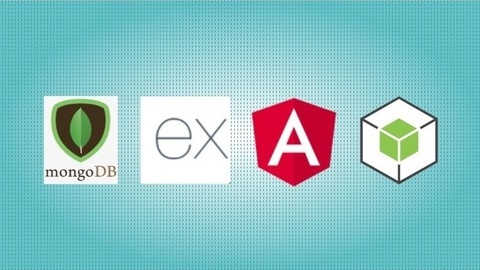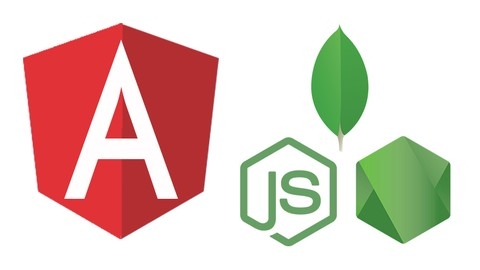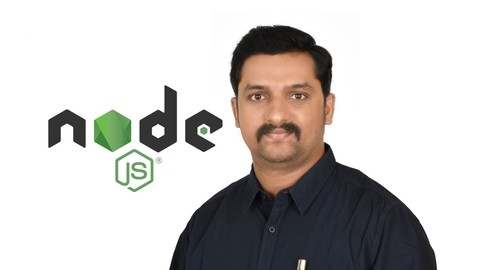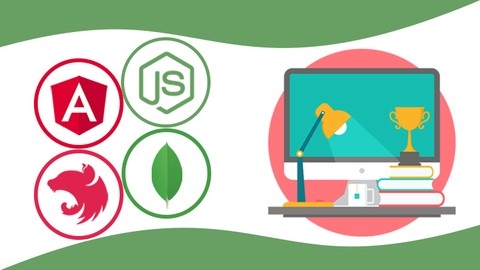The MEAN stack (MongoDB, Express.js, Angular, and Node.js) is a powerful combination of technologies used to build robust and scalable web applications.
This popular JavaScript-based stack allows developers to create dynamic, data-driven applications using a single language for both frontend and backend development.
Learning the MEAN stack can open doors to exciting career opportunities in web development, enabling you to build everything from single-page applications to complex enterprise-level systems.
With the growing demand for MEAN stack developers, finding the right course to guide you through this exciting technology landscape can be challenging.
You’re looking for a comprehensive and engaging course that covers the fundamentals, provides hands-on experience, and equips you with the skills needed to build real-world applications.
Sifting through numerous options on platforms like Udemy can be overwhelming, leaving you unsure where to begin your learning journey.
Based on our in-depth analysis of various courses, we recommend Angular & NodeJS - The MEAN Stack Guide 2024 Edition as the best overall MEAN stack course on Udemy.
This comprehensive course covers all aspects of the MEAN stack, from setting up your development environment to deploying your application.
It provides a strong foundation in each technology and guides you through building a real-world project, solidifying your understanding and preparing you for professional development.
However, we understand that everyone has different learning styles and preferences.
To cater to a wider range of needs, we’ve compiled a list of other exceptional MEAN stack courses on Udemy.
Keep reading to explore these options and find the perfect course that aligns with your specific goals and learning style.
Angular & NodeJS - The MEAN Stack Guide [2024 Edition]
You’ll start by understanding the fundamentals of the MEAN stack and how its components work together.
The course covers setting up your development environment, including installing Node.js and the Angular CLI.
You’ll then dive into building the Angular frontend, learning about components, data binding, forms, and more.
Next, you’ll integrate Node.js and Express to create a backend API, handling HTTP requests and responses.
The course covers connecting your Angular frontend to this API, as well as implementing MongoDB as the database using Mongoose.
As you progress, you’ll add advanced features like authentication, authorization, image uploads, pagination, and error handling.
The course also covers optimizations, such as separating concerns with controllers and middleware, creating Angular modules, and lazy loading.
Finally, you’ll learn how to deploy your MEAN stack application to a live server, ensuring it’s accessible to users worldwide.
Throughout the course, you’ll work on a real-world project, applying the concepts you learn to build a fully-functional web application.
The instructor provides clear explanations, code examples, and practical exercises to reinforce your understanding.
Create a MEAN App by Example - Full Stack Course
This course takes a hands-on approach to building a real-world MEAN app, so you learn by actively coding.
You begin with the user interface (UI), where you use prototyping tools to create the app’s look and feel before diving into the code.
This sets the stage for developing the app with the powerful MEAN stack, which includes MongoDB for your database, Express.js for building the backend API, Angular for the frontend, and Node.js as the runtime environment.
The course guides you through building the core features of the app.
You create a RESTful API using Express.js and Node.js, allowing communication between the frontend and the MongoDB database.
This API acts as a bridge for seamlessly retrieving and updating data.
You then develop individual components, including the home page, details page, and posts page.
You structure the data, design templates, and style the components with CSS.
Adding a touch of polish, you incorporate page transition animations, even learning to create a custom loading animation using SVG.
Finally, you learn to make the app responsive using media queries, ensuring it looks great on all screen sizes.
Practical MEAN stack Mastery course
This course teaches you to build dynamic web apps with the MEAN stack: Node.js, Express.js, MongoDB, and Angular.
You begin by installing essential tools like Visual Studio Code (VSC), npm, and MongoDB.
You quickly dive into MongoDB, exploring NoSQL databases and learning to write queries.
You then build RESTful APIs using Express.js and Mongoose to manage data in your web app.
This includes creating schemas for your data models and implementing CRUD operations (Create, Read, Update, Delete) using Postman.
You use GitHub for version control and to manage your codebase.
Next, you build the frontend with Angular.
You learn routing, creating components, and connecting to your backend API.
You style your application using Bootstrap, making it visually appealing and mobile-responsive.
You end up with a fully functional web application connecting to a backend database, handling user requests, and providing a user-friendly interface.
MongoDB, Express, React, Node, Angular (MEAN/MERN) - 5 in 1
This course teaches you how to build web applications using a set of popular technologies: MongoDB, Express.js, React.js, Node.js, and Angular.js.
First, you will discover how to use MongoDB to store data for your web applications.
You will learn how to organize this data and how to access it efficiently.
Next, you will explore Node.js, a tool that allows you to use JavaScript to build the brains of your web application.
You will learn how to handle requests from users and send back the information they need.
Then, you will dive into Express.js, which makes building web applications with Node.js easier and faster.
Finally, you’ll learn how to create the parts of the web application that users see and interact with using React.js and Angular.js.
React.js helps you build modern and responsive web applications, while Angular.js allows you to create more complex features and layouts.
Throughout this journey, you’ll be able to check your understanding and track your progress with practice tests for each technology.
You will finish the course with the skills and knowledge needed to build your own dynamic web applications.
MEAN project with Angular 4 (and 5) - Creating a CMS
This course takes you on a journey to build a complete Content Management System (CMS) right from the first line of code.
You’ll use the power of MongoDB, Express.js, Angular, and Node.js to craft a dynamic website that can handle user data and content with ease.
Imagine building the front-end of your website with Angular, using familiar languages like HTML, CSS, and Javascript.
This course shows you how to add flair and functionality with jQuery and Bootstrap, making your website look sleek and modern.
You’ll then dive into creating the backbone of your CMS using Node.js and Express.js.
Here, you’ll become familiar with RESTful APIs, the engines that power data flow between the front-end and back-end of your application.
This course teaches you to manage and store website data using both a familiar relational database, MySQL, and MongoDB, a NoSQL database.
You’ll also implement robust user authentication, so only authorized users can access specific parts of your CMS.
This includes building registration, login, and logout systems – essential features of any secure web application.
Finally, you’ll learn how to create and manage pages on your CMS, add sidebars for extra functionality, and even implement a user-friendly admin section.
You will learn how to troubleshoot common bugs, such as the ’edit same slug’ bug.
You’ll come away from this course with the confidence and practical skills to build your own web applications using the MEAN stack.
MEAN Fullstack Trello clone: WebSocket, Socket IO
This course begins by guiding you through setting up your development environment.
You will install essential tools like Node.js, Angular, and MongoDB, and configure your Node.js server.
The course recommends using VS Code as your code editor, which helps you write and manage your code.
Next, you dive into authentication, a crucial aspect of web development.
You learn how to set up Web Sockets in Node.js and use Mongoose to create a user model in your database.
You then implement both registration and login features in both the Node.js backend and the Angular frontend.
The course also covers creating secure authentication systems by building an authentication middleware in Node.js and an authentication module in Angular.
With a solid foundation in place, you then start building the core features of a Trello clone.
You learn how to create and display boards, implement inline forms for creating boards, and add a top bar with logout functionality.
You’ll even learn how to create a board module, retrieve a single board, and implement a real-time board stream using Socket.IO.
This real-time functionality will allow your users to collaborate seamlessly.
Finally, the course teaches you how to implement more advanced features such as updating board names, deleting boards and columns, updating tasks, and creating a dedicated task modal.
You then round off your learning by exploring how to deploy your fully functional MEAN stack application, allowing you to share your Trello clone with the world.
NodeJS & MEAN Stack - for Beginners - In Easy way!
This course equips you with the skills to build dynamic web applications using the MEAN stack.
You begin with NodeJS, learning to set up your environment, build a basic application, and utilize modules like the FS Module to manage files efficiently, including actions like reading, writing, and copying.
You then delve into MongoDB, a powerful database.
You learn to create databases and collections, insert and retrieve documents, and master essential commands for updating, deleting, and upserting data.
The course introduces you to Mongoose, simplifying your interaction with MongoDB by providing tools to retrieve, insert, update, and delete data efficiently.
The Http Module is your next stepping stone.
You’ll build a simple web server and learn to manage GET and POST requests, a crucial skill for web development.
This leads you to the Express framework for building robust web applications.
You discover routing, MVC architecture, and experiment with template engines such as EJS, Mustache, Handlebars, and Pug to craft dynamic web pages.
You learn about cookies, sessions, and utilize modules like Cookie-Parser and Express-Session to manage user information.
AJAX with Angular 6 is introduced to enhance your web applications’ interactivity.
You learn to fetch data from MongoDB, insert new data, and perform updates and deletions seamlessly.
Finally, the course covers unit testing using Mocha and Chai, ensuring your code’s reliability.
You also explore Socket.IO, enabling you to build real-time applications, such as chat applications, adding a dynamic dimension to your skillset.
Angular & NestJS - The Modern MEAN Stack Guide
This course guides you through building a modern MEAN stack application from scratch.
You’ll begin with the backend, mastering NestJS to build a robust REST API.
You’ll learn to structure your project, create controllers and services, and use interfaces for data management.
Connecting to a MongoDB database with Mongoose and implementing crucial features like logging and validation are also covered in detail.
You’ll then dive into frontend development with Angular, building a dynamic user interface with Angular Material.
You’ll master components, forms, and data display using techniques like the async pipe and the tap operator.
The course teaches you how to connect your frontend to the NestJS backend seamlessly using HTTP requests, ensuring a smooth and efficient data flow.
Finally, you’ll learn how to deploy your application like a pro.
You’ll connect your backend to a Cloud MongoDB Atlas database and deploy it to Heroku for a scalable and reliable solution.
You’ll then deploy your Angular frontend to Netlify, making your application accessible to the world.

![Angular & NodeJS - The MEAN Stack Guide [2024 Edition]](/img/best-angular-courses-udemy/833442_AngularNodeJS-TheMEANStackGuide2024Edition.jpg)






